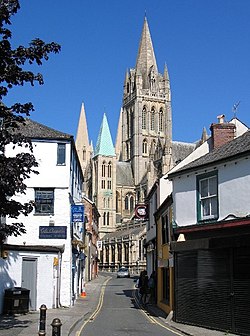Diocese of Truro
| Diocese of Truro Church of England | |
| Province: | Canterbury |
|---|---|
 Truro Cathedral from St Mary's Street | |
| Bishop: | Tim Thornton |
| Cathedral: | Truro Cathedral |
| Organisation | |
| Archdeaconries: | Bodmin, Cornwall |
| No. of parishes: | 225 |
| No. of churches: | 313 |
| Details | |
| Website: | truro.anglican.org |
The Diocese of Truro is the diocese of the Church of England serving Cornwall and the Devon parishes west of the River Tamar. It is part of the Province of Canterbury.
History
The diocese was created on 15 December 1876 from the Archdeaconry of Cornwall in the Diocese of Exeter, it is thus one of the younger dioceses.[1] It was however the revival of a much more ancient diocese serving the Cornish people which ended during the Anglo-Saxon period, which had its seat at St Germans. This bishopric was merged with its western neighbour at some point in the tenth century. When the first bishop amongst the Cornish was appointed we cannot know, but Christianity, and the institution of bishops, among the Britons is older than the Church of amongst the English.
Organisation
The diocese is divided into two archdeaconries:
- The Archdeaconry of Bodmin (est. 1878) includes Deaneries of Trigg Minor and Bodmin, East Wivelshire, Stratton, Trigg Major, and West Wivelshire
- The Archdeaconry of Cornwall includes Deaneries of St Austell, Carnmarth North, Carnmarth South, Kerrier, Penwith, Powder and Pydar
The names of the older deaneries (before 1875) are based on those of the ancient hundreds though the boundaries do not always correspond. The deaneries created in 1875 in the episcopate of Frederick Temple were Bodmin, Stratton, St Austell and Carnmarth. These remained unchanged until Carnmarth was divided; later still in the 1980s some alterations of boundaries occurred. The need for smaller deaneries was caused by the economic growth of Victorian Cornwall, mainly in tin and copper mining, which increased the population and by a greater effort by the church to encourage church membership.[2]
Coat of arms
The arms of the diocese include a saltire gules on which are a crossed sword and key: below this is a fleur de lys sable, all surrounded by a border sable charged with 15 bezants. The saltire is the cross of St Patrick, taken to be the emblem of the Celtic church; the sword and key are emblems of St Peter and Paul, the patrons of Exeter Cathedral, and the fleur de lys represents St Mary, patron of the cathedral. The border is derived from the arms of the Duchy of Cornwall.[3] They were designed by the College of Heralds in 1877 and are blazoned thus:
"Argent, on a saltire gules, a key, ward upward, in bend, surmounted by a sword, hilt upward, in bend sinister, both or. In base, a fleur de lys sable. The whole within a bordure sable, fifteen bezants. Ensigned with a mitre."[4]
Bishop of Truro
The bishop's seat is at Truro Cathedral in the City of Truro and his official residence at Lis Escop, Feock, Truro..
List of bishops
| Bishops of Truro | |||
|---|---|---|---|
| From | Until | Incumbent | Notes |
| 1877 | 1883 | Edward Benson | Translated to Canterbury |
| 1883 | 1891 | George Wilkinson | Translated to St Andrews, Dunkeld & Dunblane; later became Primus of the Scottish Episcopal Church |
| 1891 | 1906 | John Gott | |
| 1906 | 1912 | Charles Stubbs | |
| 1912 | 1919 | Winfrid Burrows | Translated to Chichester |
| 1919 | 1923 | Guy Warman | Translated to Chelmsford; later to Manchester |
| 1923 | 1935 | Walter Frere CR | |
| 1935 | 1951 | Joseph Hunkin[5] | |
| 1951 | 1960 | Edmund Morgan | |
| 1960 | 1973 | Maurice Key | |
| 1973 | 1981 | Graham Leonard | Translated to London. Apostated in 1994. |
| 1981 | 1989 | Peter Mumford | Translated from Hertford |
| 1990 | 1997 | Michael Ball CGA | Founder of the Community of the Glorious Ascension with his twin brother. |
| 1997 | 2008 | Bill Ind | |
| 2009 | present | Tim Thornton | |
| Source(s):[6][7][8] | |||
Outside links
References
- ↑ London Gazette: no. 24394, p. 6933, 15 December 1876. Retrieved 4 March 2012.
- ↑ Brown, H. Miles (1976) A Century for Cornwall; chap. 1: Anglican awakening. Truro: Blackford; pp. 1–21
- ↑ Pascoe, W. H. (1979) A Cornish Armory. Padstow: Lodenek Press; pp. 136–37
- ↑ Cornish Church Guide (1925) Truro: Blackford; p. 33
- ↑ "Joseph Hunkin in New York". Time Inc. 14 February 1938. http://www.time.com/time/magazine/article/0,9171,848822,00.html. Retrieved 20 March 2009.
- ↑ "The Bishops of Truro". The Diocese of Truro. http://www.trurodiocese.org.uk/whos-who/the-bishops-of-truro-.php. Retrieved 14 July 2012.
- ↑ "Historical successions: Truro". Crockford's Clerical Directory. http://www.crockford.org.uk/listing.asp?id=481. Retrieved 14 July 2012.
- ↑ Fryde et al. 1986, Handbook of British Chronology, p. 275.
Books
- Fryde, E. B.; Greenway, D. E.; Porter, S. et al., eds (1986). Handbook of British Chronology (3rd, reprinted 2003 ed.). Cambridge: Cambridge University Press. ISBN 0-521-56350-X.
- Donaldson, Aug. B. (1902) The Bishopric of Truro: the first twenty-five years, 1877–1902. London: Rivingtons (online version at
http://www.archive.org/stream/bishopricoftruro00dona/bishopricoftruro00dona_djvu.txt)
- Charles Henderson:
- The Cornish Church Guide Truro: Blackford, 1925 (only in part by Henderson) 1925
- The Cornish Church Guide and Parochial History of Cornwall. Truro: D. Bradford Barton, 1964 (a reissue of “Parochial History of Cornwall”, the author's principal contribution to The Cornish Church Guide published in 1925) ISBN 0-85153-052-4
- The Ecclesiastical History of Western Cornwall. 2 vols. Truro: Royal Institution of Cornwall; D. Bradford Barton, 1962
| Dioceses of the Church of England |
|---|
|
Province of Canterbury: |